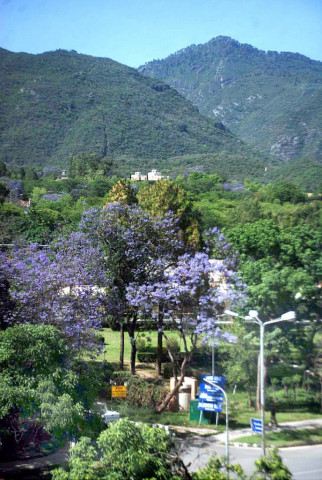‘Protected area’: Demand for gravel, turning Margallas to rubble
Rise in quarrying, deforestation coincides with significant drop in vegetation cover.

An attractive view of lush green Margallah Hills in Federal Capital City. PHOTO: APP
But perhaps for the first time, researchers have gone on to quantify the loss of vegetation and limestone exploitation in one region of Margalla Hills National Park (MHNP).
Vegetation in the southwestern part of the hills has reduced by almost half over a period of 17 years, according to a 2013 paper published in the biannual Journal of Himalayan Earth Sciences by researchers Farooq Iqbal, Mobushir Riaz Khan and Amir Malik, who work at different campuses of COMSATS Institute of Information Technology
The research findings were published a few months before the Islamabad and Punjab government administrations, urged on by a Senate environmental sub-committee, vowed in January 2014 to clear the MHNP of stone crushers.
But during the past two months, the stone crushers have not been evicted from an area of MHNP near Taxila, which the COMSATS researchers have called “limestone exploitation area” because of the dozens of stone crushers who have literally destroyed the mountains there to extract limestone.
Using remote sensing techniques and satellite images, the researchers studied land use change detection in their study area between 1992 and 2009, said Iqbal, who is a lecturer at COMSATS Islamabad’s department of meteorology.
The analysis was not done on a yearly basis. Rather, the researchers worked with four satellite images temporally spread over the 17 years, Iqbal said.
The results showed that the vegetation decreased from 23.5 per cent of the study area to just 12.1 per cent between 1992 and 2009. During the same period, limestone exploitation regions grew from only around 0.3 per cent to 5.7 per cent of the study area.
“The results showed that limestone exploitation is deteriorating the ecosystem, biodiversity, landscape and vegetation of the MHNP,” the research paper stated.
The stone crushers, which operate in southwestern part of the MHNP, are authorised by the Mines and Minerals department of the Punjab Government. Jurisdictional issues prevent the Rawalpindi Environment Protection Department from forcing the crushers to close down, said Maqbool Hussain, the EPD district officer.
Hussain said the EPD can only use the provincial environment statute to control the side effects of crushing, such as air pollution, which it has, to some extent. Faced with the risk of punishment by the Punjab Environmental Tribunal, some of the stone crushers have deployed water sprinklers to suppress the dust.
But the area’s hills are so deteriorated that some environmentalists do not even think salvation is possible.
Dr Anisur Rahman, the chief executive officer of the Himalayan Wildlife Foundation (HWF), said the southwestern edges of the Margalla Hills are “completely gone and the vegetation there is almost nonexistent.” The same goes for MHNP areas under Islamabad Capital Territory control, where a cement company and a quarry have remained operational for decades with official permission.
For Rahman, the “northern parts of MHNP are in need of severe protection.”
“In some 13 valleys in MHNP, almost no tree variety exists anymore,” Rahman said.
Some of it is because village populations have no other alternative but to chop firewood from the forest in the winters. But there is also illegal commercial harvesting, which the parks directorate of the Capital Development Authority (CDA) might be too understaffed to control.
“Just this past week, an HWF member spotted six separate commercial harvesting parties in one hour near Trail 5,” Rahman said.
It might not be possible to completely stop the limestone crushing without affecting employment and industry, but the study suggests alternative sites not far from Rawalpindi for limestone crushing, such as Khairi Murat, Kala Chitta Dhar and Khanpur.
Rahman, however, said it may be best to isolate the quarrying to one location that is already a lost cause instead of opening up new avenues of destruction.
He said the HWF has given a proposal to the CDA to devise a “financial mechanism” to protect MHNP. It might involve charging an entry fee to tourists entering the MHNP to go to popular restaurants in the hills, he said.
Rahman said part of the collections could go to hiring more CDA staff for MHNP and part of it could support alternative fuel sources for poor village communities who are dependent on firewood.
“That could be a confidence-building measure with the community,” he said. “We could financially-support them, and in return, get them to promise that not a single tree would be harmed in the MHNP forest.”
Published in The Express Tribune, March 17th, 2014.



















COMMENTS
Comments are moderated and generally will be posted if they are on-topic and not abusive.
For more information, please see our Comments FAQ